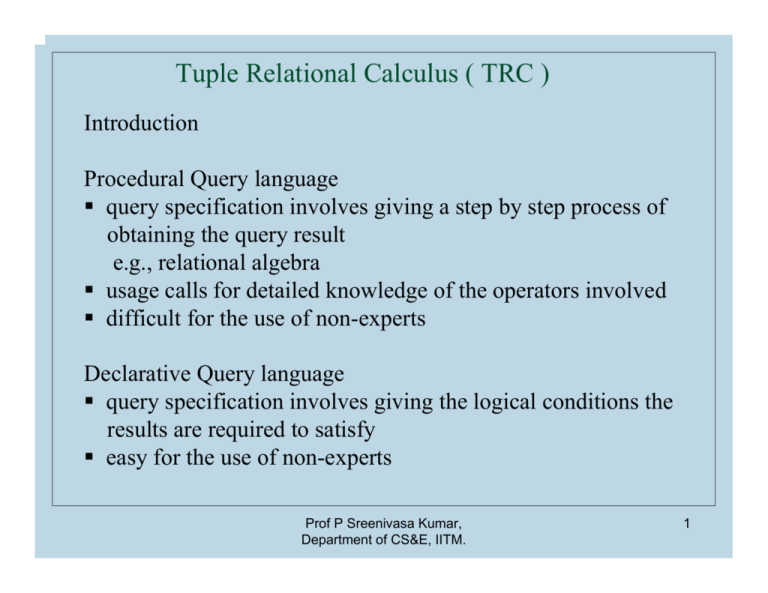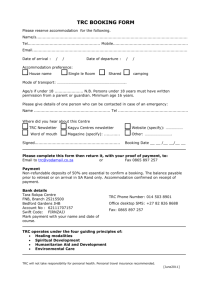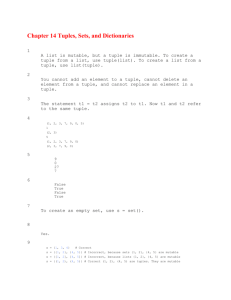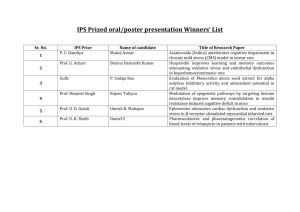
Tuple Relational Calculus ( TRC )
Introduction
Procedural Query language
query specification involves giving a step by step process of
obtaining the query result
e.g., relational algebra
usage calls for detailed knowledge of the operators involved
difficult for the use of non-experts
Declarative Query language
query specification involves giving the logical conditions the
results are required to satisfy
easy for the use of non-experts
Prof P Sreenivasa Kumar,
Department of CS&E, IITM.
1
TRC – a declarative query language
Tuple variable – associated with a relation
( called the range relation )
• takes tuples from the range relation as its values
• t: tuple variable over relation r with scheme R(A,B,C )
t.A stands for value of column A etc
TRC Query – basic form:
{ t1.Ai1, t2.Ai2,…tm.Aim | θ }
predicate calculus expression
involving tuple variables
t1, t2,…, tm, tm+1,…,ts
- specifies the condition to be satisfied
Prof P Sreenivasa Kumar,
Department of CS&E, IITM.
2
An Example TRC Query
student (rollNo, name, degree, year, sex, deptNo, advisor )
department (deptId, name, hod, phone )
Obtain the rollNo, name of all girl students
in the Maths Dept (deptId = 2)
{s.rollNo,s.name| student(s)^ s.sex=‘F’^ s.deptNo=2}
attributes
required in
the result
This predicate is true whenever
value of s in a tuple from the
student relation, false otherwise
In general, if t is a tuple variable with range
relation r, r( t ) is taken as a predicate which
is true if and only if the value of t is a tuple in r
Prof P Sreenivasa Kumar,
Department of CS&E, IITM.
3
General form of the condition in TRC queries
Atomic expressions are the following:
1. r ( t )
-true if t is a tuple in the relation instance r
2. t.Ai <compOp> t.Aj
compOp is one of {<, ≤ , >, ≥, =, ≠ }
3. t.Ai <compOp> c
c is a constant of appropriate type
Composite expressions:
1. Any atomic expression
2. F1 ∧ F2 ,, F1 ∨ F2 , ¬ F1 where F1 and F2 are expressions
3. (∀t) (F), (∃t) (F) where F is an expression
and t is a tuple variable
Prof P Sreenivasa Kumar,
Department of CS&E, IITM.
4
Interpretation of the query in TRC
All possible tuple assignments to the free variables in the query are
considered.
For any specific assignment if the expression specified to the right of
the vertical bar evaluates to true, that combination of tuple
values would be used to produce a tuple in the result relation.
While producing the result tuple, the values of the attributes for the
corresponding tuple variables as specified on the left side of the
vertical bar would be used.
Prof P Sreenivasa Kumar,
Department of CS&E, IITM.
5
Example TRC Queries
Obtain the rollNo, name of all girl students in the
Maths Dept
{s.rollNo,s.name | student(s) ^ s.sex=‘F’ ^
(∃ d)(department(d) ^ d.name=‘Maths’
^ d.deptId = s.deptNo)}
s: free tuple variable
d: existentially bound tuple variable
Existentially or universally quantified tuple variables can be used
on the RHS of the vertical bar to specify query conditions
Attributes of free (or unbound ) tuple variables can be used on LHS
of vertical bar to specify attributes required in the results
Prof P Sreenivasa Kumar,
Department of CS&E, IITM.
6
Examples Queries in TRC
1)Determine the departments that do not have
any girl students
{d.name|department(d) ^
¬(∃ s)(student(s) ^
s.sex =‘F’ ^ s.deptNo = d.deptId)
Prof P Sreenivasa Kumar,
Department of CS&E, IITM.
7
Examples Queries in TRC
2)Select the courses enrolled by student of a given
name, say Mahesh
{c.name | course(c) ^
(∃s)(∃e) ( student(s) ^ enrollment(e)
^ s.name = “Mahesh”
^ s.rollNo = e.rollNo
^ c.courseId = e.courseId }
3)Select the students who have scored ‘S’ in all
subjects they have enrolled. Assume that every
student is enrolled in at least one course
{s.name | student(s) ^
(∀e)((enrollment(e) ^
e.rollNo = s.rollNo)
Prof P Sreenivasa Kumar,
Department of CS&E, IITM.
→ e.grade =‘S’)}
8
Examples Queries in TRC
4) Select students who have taken at least one
course taught by their advisor
{s.name | student(s) ^
(∃e)(∃t)(enrollment(e) ^ teaching(t) ^
e.courseId = t.courseId ^
e.rollNo = s.rollNo ^
t.empId = s.advisor}
5) Display the departments whose HODs are teaching
at least one course in the current semester
{d.name | department(d) ^(∃t)(teaching(t) ^
t.empid = d.hod
^ t.sem = ‘odd’ ^ t.year = ‘2006’)}
Prof P Sreenivasa Kumar,
Department of CS&E, IITM.
9
Examples Queries in TRC
6)Determine the students who are enrolled for every
course taught by Prof Ramanujam. Assume that Prof
Ramanujam teaches at least one course.
1. {s.rollNo | student (s) ^
2.
(∀c)(course (c) ^
3.
((∃t),(∃p)( teaching(t) ^ professor(p) ^
4.
t.courseId = c.courseId ^
5.
p.name = “Ramanujam” ^
6.
p.empId = t.empId )) →
7.
(∃e) (enrollment(e) ^
8.
e.courseId = c.courseId ^
9.
e.rollNo = s.rollNo)
10.
)
11. }
Prof P Sreenivasa Kumar,
Department of CS&E, IITM.
10
Expressive power of TRC and Relational Algebra
It can be shown that
both Tuple Relational Calculus and Relational Algebra
have the same power of expression
A query can be formulated in TRC
if and only if it can be formulated in RA
Both can not be used to formulate queries involving
transitive closure
-- find all direct or indirect pre-requisites of a course
-- find all subordinates of a specific employee etc.
Prof P Sreenivasa Kumar,
Department of CS&E, IITM.
11










